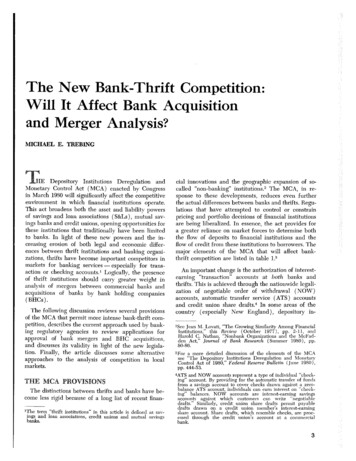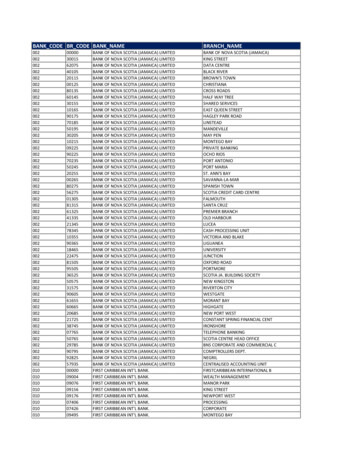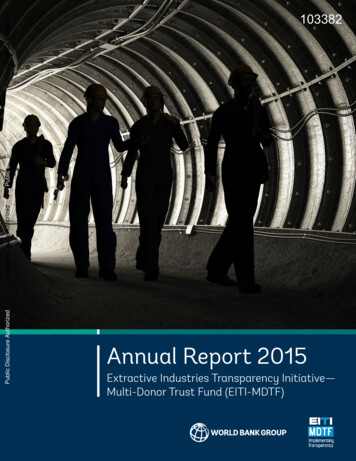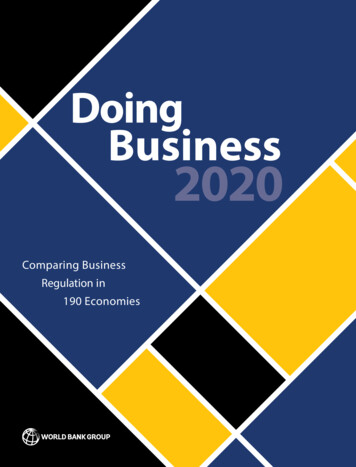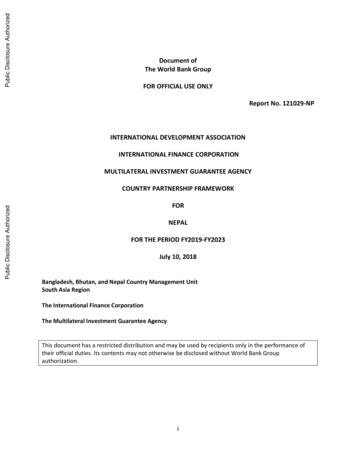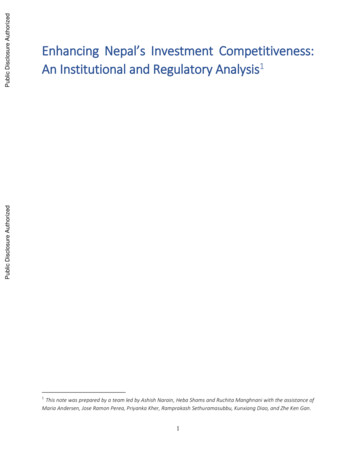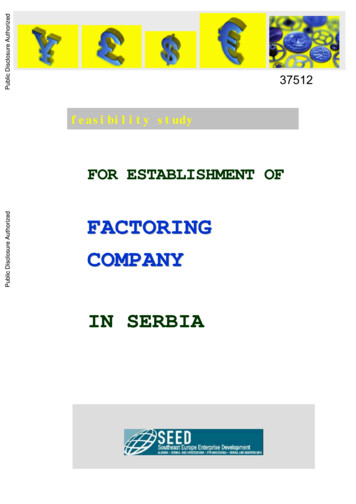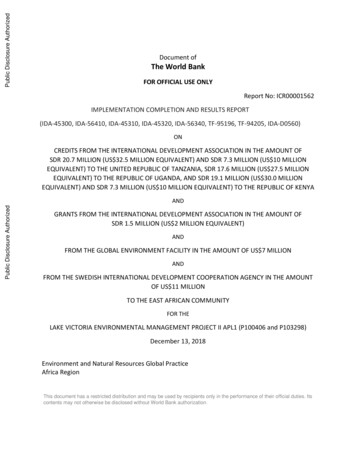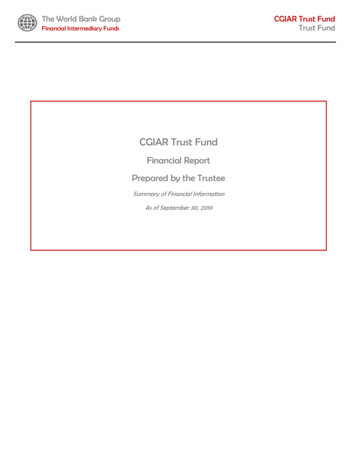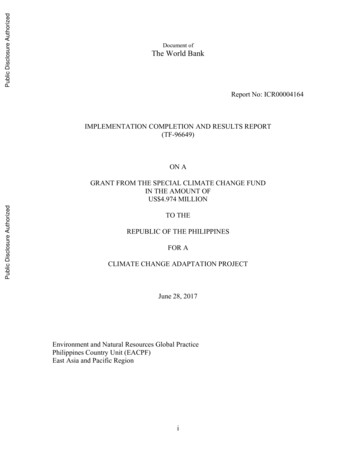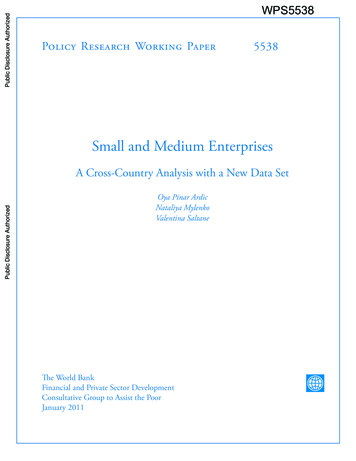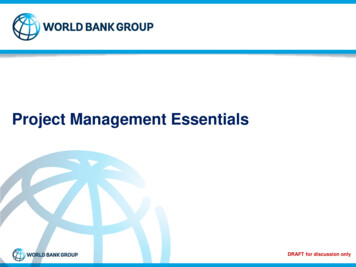
Transcription
Project Management EssentialsDRAFT for discussion only
Our Approach to the WorkshopDiscussionWe will introduce themodule topic with aninitial discussion on thetopic’s relevanceObjectivesLeadingPracticesWe will discuss leadingpractices in ProjectManagement andidentify elements thatwill help us succeed inthe fieldKnowledgeCheckEach module begins with Knowledge checks afterobjectives to ensure youeach leading practiceunderstand what we will section help you retainlearnfoundational informationTools & UsageCase ActivityA deep dive into toolsYou will team up andshow you the relevance apply leading practicesand application method and tools to a case studyfor each toolexampleSummary &ReflectionA concise summaryhelps you solidify keytakeaways from themodule and reflectionprovides an opportunityto discuss how you willapply PM skills2
Course Agenda – Day 1TopicDescriptionModule 1: Project Design Module 2: Project Planning Project Planning Overview Activity Planning Network AnalysisModule 3: Resource Planning & Budgeting Resource Planning & Budgeting Overview Cost Management BudgetingProject Design OverviewProject Planning MatrixLogic StructureWork Breakdown Structure (WBS)3
Course Agenda – Day 2TopicDescriptionModule 4: Risk Management Risk Management Overview Risk Management LifecycleModule 5: Stakeholder Management Stakeholder Management Overview Stakeholder AnalysisModule 6: Implementation Management Wrap-up & Evaluation Training Recap Final RemarksImplementation Management OverviewImplementation TrackingMonitoring Implementation ActivitiesClosing-Out Implementation Activities4
Module 1: Project Design
Project DesignThe Project Design Module includes both the Logic Model and Work BreakdownStructureWork Breakdown StructureLogic ModelEach unit incorporates a holistic learning approach with the following key components:Introduction& ObjectivesLeadingPracticesTools &UsageCaseActivitySummaryReflection6
Project Design Learning ObjectivesAfter This Unit, You Can: Understand the key steps in Project Design Identify the components of a Logic Model and their relationship Put the Logic Model in the context of Project Management Define a Work Breakdown Structure (WBS) and list the steps to create one Explain why the WBS is the foundation of a project Use the Logic Model and WBS Templates in a real-life situation7
The Project Planning MatrixIndicatorsMeans icatorsSource icatorsSource ofInformationAssumptions, RisksOutputsOutputIndicatorsSource ofInformationAssumptions, RisksService / ProductDeliveryHierarchy ofObjectivesResultsThe PPM is the Overview of the ProjectActivitiesResources InputsExternal Factors(Assumptions, Risk)Assumptions, Risks9
The Logic Model – The Intervention LogicThe five core components of the Logic Model include Inputs, Activities, Output,Outcome, and ImpactOpportunity to Increase EffectivenessOpportunity to Increase Efficiency5. Inputs4. ActivitiesResources associated Actions taken towith the projectproduce results(i.e. what will itcost to deliver theproject?)3. OutputThe deliveredservices that resultfrom a series ofactivities2. OutcomeThe objective theproject isdesigned tocontribute to1. ImpactThe effect of theproject on thebroader environmentPerformance Indicators10
WBS TemplateThe WBS template should be used to capture 100% of the work defined by theproject scope, and to capture all deliverables5. Inputs4. Activities3. Output2. Outcome1. ImpactIMPACTOUTCOMEWBS Alignmentwith nputsInputsInputsInputs11
The Work Breakdown Structure (WBS)Work Breakdown Structure (WBS) is a hierarchical breakdown of elements of thelogic model. The WBS serves to organize and define the total scope of the projectDecomposition: The subdivision of project deliverablesinto smaller, more manageable components until the workand deliverables are defined to the Activity, Sub-Activity orTask LevelITip: Create a WBS for the project before completing aConcept Note. The WBS will assist with determining thecontent for the Concept Note12
The WBS is the Foundation of the ProjectWBS is the link to project design and the first project planning activity1. What do I need to do?WBSRefine ScopeDefineActivities2. What do I do first? Howlong will it take?StartFinishSchedulingNetworkDiagram3. What resources will be needed?BudgetingResources13
Activity Planning TemplateThe Activity Planning Template helps align the logic model elements with the WBSIMPACTLinkOutcometo#OCs20% private .32.4OC1OUTCOME (OC)Reduction of timeto obtain newlicenseLinktoOPsOP1;OP2Output#OP1OUTPUT (OP)ACTY#ACTIVITY1As-is process mapping and analysis2Process re-engineeringLicensing ReformSUB-ACTIVITYReview and analyze previous reform efforts, past effortsMapping and diagnostics of the 6 trade and 4 non-tradeDesign survey re: experiences with licensingConduct surveyAs-is process mapping analysis completedIdentify best practices relevant to Afghan contextStudy as-is analysis, suggest reform proposals, setObtain endorsement of new process by Minister ofProcess re-engineering completePREDECResourceE-SSORS 5/4/1114
Module 2: Project Planning
Project Planning Learning ObjectivesAfter This Unit, You Can: Systematically identify relevant activities to achieve required outputs Define network analysis and its uses in project planning Perform a forward pass, a backward pass, and calculate a float Identify the critical path in your project plan16
Activity SchedulingDefining what goes first and how long activities take is the second step1. What do I need to do?WBSRefine ScopeDefineActivities2. What do I do first? Howlong will it take?StartFinishSchedulingNetworkDiagram3. What resources will be needed?BudgetingResources17
Activity Planning StepsActivity Planning typically includes three steps that allow the project schedule to becreatedPlanning StepDescription1. ActivityDefinitionIdentify activities thatwill generate projectresults2. ActivitySequencingIdentify the order ofactivities, consideringtheir relationship3. ActivityDurationEstimatingEstimate the timeneeded to completeactivitiesOutcomeProject ScheduleProper activity planning provides the framework for developing an integrated project approach andimplementation plan, ultimately allowing for the creation of the project’s Design Document18
Defining ActivitiesOutputs should be decomposed into activities that allow the project to achieve thedesired impact. These activities are typically:EstimatedManagedMeasuredEach activity outlined within the WBS must be complete and accurate, as it will beleveraged to develop the project yActivityActivityActivityActivityActivity19
Network Diagram TemplateThe Network Diagram Template may be created to schematically show thesequencing of projectsStartFinishA completed network diagram can be used to identify the critical path of a project, which is theseries of dependent activities that determines the shortest possible duration of a project20
Activity Duration EstimatingConsider these elements in estimating the number of work periods that will beneeded for each activity Potential and available resources and capabilities Constraints Delays and lag-times Risks and build-in reserve/contingency time Input from subject matter experts and historical information Assumptions Start and end dates for project activities21
Tools for Activity Planning and Network AnalysisMicrosoft Project is available for you to use as a Project Management toolMicrosoft Project Requires buying a license Industry standard; widelyaccepted and used in thecorporate environment Extensive help resources onlineand offline Does not require Java Excellent scheduling, resourceplanning, and cost tracking tool22
Module 3: Resource Planning &Budgeting
Resource Planning & Budgeting Learning ObjectivesAfter This Unit, You Can: Understand key restrictions to project management List steps involved in estimating resource requirements Understand elements that drive costs on a project Complete a resource estimation worksheet24
Estimating ResourcesThe third step, estimating resources, is critical for project success1. What do I need to do?Refine ScopeWBSDefineActivities2. What do I do first? Howlong will it take?StartFinishSchedulingNetworkDiagram3. What resources will be needed?BudgetingResources25
Cost Management ProcessesIn a competitive budgetary environment, formal cost management is a crucialproject management skillThree interactive processes are required to manage costs effectively:1. Estimate Costs(Planning)2. Determine Budget(Planning)3. Control Costs(Monitoring &Controlling)26
Costs, Budgets, and MonitoringBy spending the appropriate time estimating costs, determining the budget, andcontrolling costs, the project can achieve its objectivesEstimate Costs(Planning)Determine Budget(Planning)Control Costs (Monitoring& Controlling)Inputs:Inputs:Inputs: Scope Activity Cost Estimates Project Management Plan Project Schedule Basis of Estimates Project Funding Requirements Risk Analysis Resource Calendars Staff and Consultant Updates Assumptions Contracts Type/Availability of Resources Consulting ResourcesTools & Techniques: ForecastingTools & Technique:Tools & Techniques: Performance Reviews Design to Budget Cost Aggregation Project Management Software Top-down Estimating Expert Judgment Bottom-up Estimating Budget RevisionOutputs: Budget ForecastsOutput:Outputs: Change Requests Activity Cost Estimates Cost Performance Baseline Project Management Plan Updates Basis of Estimates Project Funding Requirements Project Document Updates Project Document Updates27
Estimating by Type of ResourcePeople and travel drive the majority of the project expensesEstimate Activity Resources:Estimate the type and quantities of people, travel and other project costs required foreach activityPeopleBoth staff and consultants need tobe reflectedTravelTransportation and all othertravel-related expensesOther CostsMaterials, leases, and all otherservices or overhead28
Types of CostsConsider the impact of various types of costs on expense over timeDirect Costs Costs directly attributable to project work Examples: team travel; salaries; cost ofmaterialsFixed Costs Costs that do not change as productionchanges Examples: leases; other pre-arrangedcontractsVersusIndirect Costs Overhead items or costs that benefitmore than one project Examples: office support staff; use ofoffice spaceVersusVariable Costs Costs that change with the scope andtime spent Examples: staff salary; consultant fees29
Incorporating Costs within WBSWhen planning your activities, consider how the various activities and WBS outputswill effect costs and overall ActivityInputsInputsInputsInputsConsider thecosts associatedwith each workstream’sactivitiesConsider the costs associated with the inputs related to eachwork stream30
Budgeting TechniquesVarious budgeting techniques can be used depending on the projectDesign-to-Budget:Top-down Estimating:Bottom-up estimating:Used when the project budget isfixed. Costs are estimated byworking backwards from the totalbudget through prioritizing andassessing requirements until theproject can be completed withinavailable budget.This approach typically relies oncost histories from past projects,and knowledge of the specificparameters of those projects.Requires a cost estimate to bedeveloped for each of the workpackages in the WBS. Then,once the cost of each workpackage is estimated, theestimates can be added togetherto compile the total project costestimate.While top-down estimation is a quick way to establish a baseline for the project, it is rarely sufficientfor estimating project costs and should always be accompanied with a bottom-up estimationtechnique31
Considerations for Resource Planning & BudgetingAssumptions, risks, and external environment play a role in resource planning andbudgeting, potentially impacting total costsRisks Decrease of supply inputs Presence of competitors insimilar marketExternal Environment Political tensions Economic climate Environmental regulationsAssumptions Time required Resource availabilityResourcePlanningandBudgeting32
Project Management EssentialsDay 2DRAFT for discussion only
Course Agenda – Day 2TopicDescriptionModule 4: Risk Management Risk Management Overview Risk Management LifecycleModule 5: Stakeholder Management Stakeholder Management Overview Stakeholder AnalysisModule 6: Implementation Management Wrap-up & Evaluation Training Recap Final RemarksImplementation Management OverviewImplementation TrackingMonitoring Implementation ActivitiesClosing-Out Implementation Activities34
Module 4: Risk Management
Risk Management Learning ObjectivesAfter This Unit, You Can: Define risk, opportunity, and risk management Understand the importance of risk management List and define 5 general kinds of risk Explain the 4 steps in the risk management process Develop a plan to mitigate risks using a risk log Continually monitor and update risks over a project life cycle36
Introduction to Risk ManagementRisk is the probability of a condition or event with a negative imp
Project Management Plan Updates. Estimating by Type of Resource People and travel drive the majority of the project expenses 28 Estimate Activity Resources: Estimate the type and quantities of people, travel and other project costs required for each activity People Both staff and consultants need to be reflected Travel Transportation and all other travel-related expenses Other Costs .File Size: 2MBPage Count: 67

